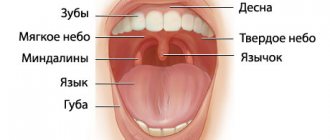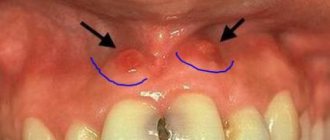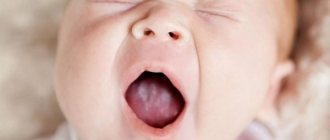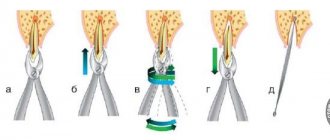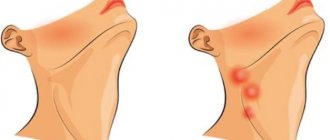Child's nose, nasal mucosa in children
The nose of a young child is relatively small, the nasal passages are narrow, and the lower nasal passage is absent. The nasal mucosa is delicate, relatively dry, and rich in blood vessels. Due to the narrowness of the nasal passages and the abundant blood supply to their mucous membrane, even minor inflammation causes difficulty breathing through the nose in young children. Breathing through the mouth is impossible in children in the first six months of life, since the large tongue pushes back the epiglottis. The exit from the nose, the choanae, is especially narrow in young children, which is often the cause of long-term disruption of nasal breathing in them.
Causes of tonsillitis
Tonsillitis is an infectious disease that occurs as a result of a bacterial, viral or fungal infection.
Most often, the disease is caused by bacteria - streptococci, staphylococci, pneumococci and hemophilus influenzae. Viral tonsillitis can be caused by herpes, influenza and parainfluenza viruses, as well as enterovirus and adenovirus infections. In rare cases, the cause of the disease is fungi, mycoplasma and chlamydia. Pathogenic microorganisms enter the child's respiratory tract through airborne droplets, transmitted from person to person. A healthy body is able to overcome an infection on its own; infection occurs only if there are factors that contribute to a decrease in the child’s body’s defenses, for example:
- hypothermia;
- avitaminosis;
- the presence of chronic inflammatory diseases in the oral cavity and pharynx - caries, stomatitis, pharyngitis, etc.;
- frequent contact with sick people;
- poor environmental conditions, dusty air;
- exposure to external irritants and allergens.
In addition, tonsillitis often occurs in children with peculiarities of the anatomical structure of the lymphoid apparatus of the nasopharynx - deep and narrow lacunae of the tonsils, multiple slit-like passages and adhesions, which complicate the process of emptying the lacunae.
Paranasal sinuses in children
The paranasal sinuses in young children are very poorly developed or completely absent. As the facial bones (upper jaw) increase in size and teeth erupt, the length and width of the nasal passages and the volume of the paranasal sinuses increase. By the age of 2 years, the frontal sinus appears, and the maxillary cavity increases in volume. By the age of 4, the lower nasal passage appears. These features explain the rarity of diseases such as sinusitis, frontal sinusitis, ethmoiditis in early childhood. Consultations with a pediatric ENT specialist at the Markushka clinic.
How to recognize?
The first thing a baby will complain about with chronic tonsillitis is a sore throat and painful swallowing. However, if the child is under 3 years old, he cannot always explain what is bothering him. Therefore, it is important for parents to pay attention to the accompanying symptoms:
- The appearance of bad breath;
- Nervous system disorders: frequent whims and crying, anxiety, rapid fatigue and poor sleep.
- These are the first symptoms, the manifestation of which can be missed. After them, as a rule, the child develops:
- Low temperature (up to 37.5 degrees);
- Nasal congestion and enlarged lymph nodes;
- The tonsils increase in size and purulent plugs appear on them;
- Possible simultaneous occurrence of otitis media or sinusitis.
In young children, the inhaled air is poorly warmed
Due to the insufficient development of cavernous tissue in young children, the inhaled air is poorly warmed up; therefore, children should not be taken outside at temperatures below -10 degrees. C. Cavernous tissue develops well by the age of 8-9 years, this explains the relative rarity of nosebleeds in children of the 1st year of life. A wide nasolacrimal duct with underdeveloped valves contributes to the transfer of inflammation from the nose to the mucous membrane of the eyes (examination by a pediatric ophthalmologist at the Markushka clinic). Passing through the nose, atmospheric air is warmed, moistened and purified. Every 10 minutes, a new layer of mucus passes through the nasopharynx, which contains bactericidal substances (lysozyme, complement, etc.), secretory immunoglobulin A.
How to treat caseous plugs
What you absolutely should not do is try to remove the plugs yourself. “Picking” your tonsils with your finger or foreign hard objects will not only not relieve you of the disease, but will also aggravate it. The deposits will clog even deeper, and the infection will only grow.
Rinsing in this case is also not an option. Although patients note some relief, the medicinal solution only washes the surface of the tonsils, but, unfortunately, does not “wash out” the plugs.
Therefore, with this problem you should contact an ENT doctor, therapist or dentist. At some stages, treatment of the disease is not required, but if necessary, a specialist will perform professional cleansing of the tonsils. This procedure can be carried out in two ways:
- manually - the doctor rinses the recesses in the tonsils with a syringe with a special solution;
- using devices - vacuum suction, ultrasound, etc. are used.
As a rule, the treatment of caseous plugs is approached in a comprehensive manner, adding medications and physiotherapeutic procedures to cleansing the tonsils.
Patients who notice white deposits on their tonsils, bad breath, or a sore throat should definitely consult a doctor. After all, in the early stages it is much easier to eliminate the disease.
Tonsils, adenoids in a child, children
By the age of 4-10 years, the tonsils are already well developed, and their hypertrophy can easily occur. During puberty, the tonsils begin to undergo reverse development.
The tonsils are like a filter for microbes, but with frequent inflammatory processes, a focus of chronic infection can form in them, causing general intoxication and sensitization of the body.
The proliferation of adenoids (nasopharyngeal tonsil) is most pronounced in children with constitutional abnormalities, in particular with lymphatic-hypoplastic diathesis. If the adenoids are significantly enlarged (degree 1.5-2), they are removed, since nasal breathing is impaired in children (children breathe with an open mouth - the air is not purified and warmed through the nose, and therefore they often suffer from colds), the shape of the face changes (adenoid face), children become distracted (mouth breathing distracts attention), and their academic performance deteriorates. When breathing through the mouth, posture is also disturbed; adenoids contribute to the formation of malocclusion. Treatment of adenoids - homeopathic pediatrician, Markushka clinic.
Inflammation of the tonsils in a child
Tonsils are lymphoid tissues containing lymphocytes that prevent microorganisms from entering the human body during inhalation of air. In normal condition, the tonsils resemble acorns or almond grains and are pink in color, but in the case of inflammatory processes their appearance changes.
The tonsils are the first protective barrier to human health against microorganisms that enter the body through the nose and mouth. As a result of such contact, inflammation of the tonsils in the child is possible, which is highly desirable to be recognized in a timely manner.
Doctors at the Kids MED clinic will talk about the symptoms and rules for treating inflammatory processes.
Symptoms and diagnosis
It is very easy to detect inflammation of the tonsils in a child. This is evidenced by clearly visible changes:
- Color change. The tonsils do not become pink, but bright red or dark red.
- Change of size. In the case of a prolonged inflammatory process, the tonsils greatly increase in size, in addition, their structure becomes loose.
- The appearance of plaque. In some cases, inflammation is accompanied by the formation of yellowish plaque on the tonsils and the appearance of purulent, unpleasant-smelling plugs.
- Common signs of a cold. Simultaneously with the change in the appearance of the tonsils, the child experiences sensations characteristic of colds - headache, sore throat, high temperature, chills, weakness, etc.
Inflammation of the tonsils has a special scientific name - tonsillitis; it can be acute and even chronic.
Most often, children suffer from tonsillitis during the cold season, which is when various colds and viral diseases peak. Since the symptoms of inflammation of the tonsils can be confused with influenza, streptococcus and other diseases, the diagnosis should be made by a qualified specialist.
You should definitely go to the doctor if the symptoms described above occur, and also if the baby has problems sleeping, swallows sick, has a cough and the temperature lasts for 3 days or longer.
If the child feels very bad, then you should not hesitate under any circumstances. In some situations, it is better for parents to call an ambulance so that the necessary drug treatment can be started in a timely manner.
Causes of inflammatory processes
A child's tonsils can become inflamed for a variety of reasons. Most often, tonsillitis occurs due to:
- general weak immunity and low body resistance;
- transmission of infection from sick people or contaminated household items;
- hypothermia;
- focal inflammation of the nasopharynx;
- unfavorable living conditions;
- poor, insufficient or untimely nutrition.
Regardless of the cause of health problems, the child requires timely assistance. Without it, all sorts of unpleasant complications are possible, threatening not only the health, but also the life of the baby.
Professional diagnosis and treatment
Only a qualified physician with extensive experience and professional knowledge can make a correct diagnosis of a child. He will also be able to prescribe appropriate therapeutic treatment that can quickly improve the baby’s well-being and prevent the occurrence of new health problems.
If you have any questions about inflammation of the tonsils in a child, you can always seek help from the Kids MED children's clinic in Krasnodar.
We have experienced and competent doctors who will help you solve any problem. To the list of articles
Larynx in children
The larynx in young children has a funnel-shaped shape (later - cylindrical) and is located slightly higher than in adults (at the level of the 4th cervical vertebra in a child and the 6th cervical vertebra in an adult). The larynx is relatively longer and narrower than in adults; its cartilages are very pliable. The false vocal cords and mucous membrane are delicate, rich in blood and lymphatic vessels, elastic tissue is poorly developed. The glottis in children is narrow. Young children's vocal cords are shorter than older children's, which is why they have a high-pitched voice. From the age of 12, boys' vocal cords become longer than girls'. These features of the larynx explain the easy development of stenotic phenomena in children, even with moderate inflammatory changes in the mucous membrane of the larynx.
The increased neuromuscular excitability of a small child is also of great importance. Hoarseness, often observed in young children after a cry, often depends not on inflammatory phenomena, but on the weakness of the easily fatigued muscles of the vocal cords.
Symptoms
Signs that indicate enlarged tonsils are the following:
- the lymphoid gland changes in size. This is established by external palpation,
- pain in the nasopharynx,
- difficulty swallowing food,
- dysfunction of the respiratory system,
- occurrence of sleep problems,
- red throat with irritation arising in it,
- increase in body temperature.
As the tonsils increase in size, the general condition of the child worsens . He begins to feel weak, but his state of apathy quickly gives way to irritability. It becomes difficult for the child to breathe, not only through the nose, but also through the mouth. Often the baby shows signs of inexplicable fear. He looks lethargic and demonstrates poor motor activity. He has no desire to play. The child's appetite is poor , he eats little and drinks little liquid.
The process of inflammation of the tonsils often occurs with the appearance of a specific odor from the oral cavity. The organs adjacent to the tonsils - lymph nodes and adenoids increase in size during inflammation. This is the outcome of the developed inflammatory process. This can be determined by green-gray nasal discharge or a yellow coating on the tongue and tonsils, as well as a specific odor from the mouth. With inflamed tonsils, body temperature can rise sharply to 40 degrees , or its increase can occur gradually.
Trachea in a child, children
The trachea in newborns is funnel-shaped, its lumen is narrow, the posterior wall has a wider fibrous part, the walls are more pliable, the cartilage is soft and easily compressed. Its mucous membrane is delicate, rich in blood vessels and dry due to insufficient development of the mucous glands, elastic tissue is poorly developed. The secretion of the glands provides a layer of mucus on the surface of the trachea 5 microns thick, the speed of which is 10-15 mm/min (provided by cilia). The growth of the trachea occurs in parallel with the growth of the body, most intensively in the 1st year of life and during puberty. The structural features of the trachea in children lead to the easy occurrence of stenotic phenomena during inflammatory processes; frequent isolated lesions (tracheitis), combined with damage to the larynx (laryngotracheitis) or bronchi (tracheobronchitis) are determined. In addition, due to the mobility of the trachea, its displacement may occur during a unilateral process (exudate, tumor).
Bronchi in a child, children
The bronchi are quite well formed at birth. The growth of the bronchi is intense in the 1st year of life and during puberty. Their mucous membrane is richly vascularized, covered with a layer of mucus, which moves at a speed of 3-10 mm/min, in the bronchioles it is slower - 2-3 mm/min. The right bronchus is like a continuation of the trachea; it is shorter and wider than the left. This explains the frequent entry of a foreign body into the right main bronchus. The bronchi are narrow, their cartilage is soft. Muscle and elastic fibers in children of the 1st year of life are not yet sufficiently developed. The tenderness of the bronchial mucosa and the narrowness of their lumen explain the frequent occurrence of bronchiolitis with complete or partial obstruction syndrome in young children.
Prevention of tonsillitis
In order to prevent tonsillitis in a child, parents should adhere to the following rules:
- Gradually harden the child's body.
- Provide your child with a balanced, healthy diet containing all the nutrients necessary for childhood.
- From a very early age, introduce the child to sanitary standards - the rules of washing hands, brushing teeth, etc.
- Promptly eliminate any inflammatory processes in the oral cavity and pharynx.
- Avoid crowded places during epidemic periods.
- Do not self-medicate!
At the SM-Doctor clinic for children and adolescents, tonsillitis is diagnosed and treated by specialists with many years of experience in otolaryngology. The use of modern high-tech equipment allows our doctors to achieve high results in the treatment of ENT diseases. Sign up for a consultation with qualified pediatric otolaryngologists!
Lungs in children, child
The lungs of newborns weigh about 50 g by 6 months. their mass doubles, triples by the age of 12, increases 10 times by the age of 12, and 20 times by the age of 20. The pulmonary fissures are poorly expressed.
In newborns, the lung tissue is less airy, with abundant development of blood vessels and connective tissue in the septa of the acini and an insufficient amount of elastic tissue. The latter circumstance explains the relatively easy occurrence of emphysema in various pulmonary diseases.
The formation of the lung structure in children depends on the development of the bronchi
The formation of the lung structure occurs depending on the development of the bronchi. After the trachea divides into the right and left main bronchi, each of them is divided into lobar bronchi, which approach each lobe of the lung. Then the lobar bronchi are divided into segmental bronchi. Each segment has independent ventilation, a terminal artery and intersegmental septa made of elastic connective tissue.
The segmental structure of the lungs is already well expressed in newborns. There are 10 segments in the right lung, 9 in the left. The upper left and right lobes are divided into three segments - 1, 2 and 3rd, the middle right lobe - into two segments - 4th and 5th. In the left lung, the middle lobe corresponds to the lingular lobe, which also consists of two segments - the 4th and 5th. The lower lobe of the right lung is divided into five segments - 6, 7, 8, 9 and 10th, and the left lung - into four segments - 6, 8, 9 and 10th. In children, the pneumonic process is most often localized in certain segments (6, 2, 10, 4, 5), which is associated with the characteristics of aeration, the drainage function of the bronchi, the evacuation of secretions from them and possible infection.
External respiration , that is, the exchange of gases between atmospheric air and the blood of the capillaries of the lungs, is carried out through simple diffusion of gases through the alveolar-capillary membrane due to the difference in the partial pressure of oxygen in the inspired air and venous blood flowing through the pulmonary artery into the lungs from the right ventricle. Compared to adults, young children have pronounced differences in external respiration due to the development of acini, numerous anastomoses between the bronchial and pulmonary arteries, and capillaries.
General rules for treatment
Self-medication is strictly prohibited. If parents discover a red throat in a child, it is necessary to contact a specialist to clarify the diagnosis and prescribe a course of treatment. READ ALSO: A child has a red throat: how to treat inflammation at home?
Medication approach
Depending on the disease, the doctor prescribes medications to relieve inflammation. Medicines, especially antibiotics, cannot be selected independently - many of them have serious side effects. The following agents are used in therapy:
- For bacterial infections of the pharynx and sore throat, the antibiotics Augmentin and Amoxicillin are used.
- The drugs Umkalor, Tonsilgon and Lymphomyosot have antimicrobial and antiviral properties (for more details, see the article: Tonsilgon drops: instructions for use for children under one year old). They are available in the form of drops, which is convenient for treating small children. The remedies fight the disease, eliminate unpleasant symptoms and help improve immunity.
- For herpes and other types of viral infections, interferons, Tamiflu, Remantadine, Lavomax, Acyclovir are prescribed.
- If the disease is caused by fungi, the specialist prescribes Fluconazole or Levorin (we recommend reading: instructions for use of Fluconazole for children).
- For redness of the throat caused by an allergic reaction, antihistamines (Xyzal, Cetrin, Ebastine, Zyrtec) are prescribed. It is necessary to completely exclude the baby’s contact with the irritant.
- If a nonproductive cough is added to the redness of the throat, drugs to thin and remove mucus - Prospan, Ambroxol, etc. - are included in the treatment regimen.
- To reduce body temperature and relieve pain, Nurofen and Paracetamol are used.
Local treatment for a sore throat
To relieve the symptoms of the disease, topical agents are often used:
- Sprays Tantum Verde, Ingalipt, Bioparox, Chlorophyllipt act as antiseptics (we recommend reading: Tantum Verde spray: analogues of the drug for children). The drug sprayed onto the mucous membrane reduces pain and softens the throat. Active components fight pathogenic flora.
- Tantum Verde and Septolete lollipops have a “cooling” effect and reduce pain. Excellent help with dry cough and sore throat. By sucking the lozenges and swallowing saliva, the child removes the mucus accumulated in the throat.
- Miramistin solution, as well as the preparations Tanin (1-2%) and Antiformin are antiseptics used for gargling. Regular procedures gradually clear the mucous membrane of plaque. The active substances in the solutions destroy pathogens and relieve inflammation.
- Silver Nitrate solution 0.25% or Lugol's - for periodic lubrication of the tonsils (we recommend reading: how to use Lugol's as a spray for children?). Used to relieve inflammation and reduce pain.
- A solution of salt and soda with the addition of a few drops of iodine or chamomile decoction reduces discomfort and acts as an antiseptic.
- Compress made of rye flour, honey and vegetable oil. Mix the mixture until it has the consistency of dough, heat it in a water bath and apply it to the sore throat for 20 minutes. The product relieves swelling, inflammation and pain.
Depth of breathing in children
The depth of breathing in children is much less than in adults. This is explained by the small mass of the lungs and the structural features of the chest. The chest in children of the 1st year of life seems to be in a state of inhalation due to the fact that its anteroposterior size is approximately equal to the lateral size, the ribs extend from the spine almost at a right angle. This determines the diaphragmatic nature of breathing at this age. A full stomach and bloated intestines limit the mobility of the chest. With age, it gradually moves from the inspiratory position to the normal one, which is a prerequisite for the development of thoracic breathing.
Oxygen requirements in children are significantly higher than in adults
The oxygen requirement in children is much higher than in adults. Thus, in children of the 1st year of life, the need for oxygen per 1 kg of body weight is about 8 ml/min, in adults - 4.5 ml/min. The shallow nature of breathing in children is compensated by a high breathing frequency (in a newborn - 40-60 breaths per 1 minute, at the age of 1 year - 30-35, 5 years - 25, 10 years - 20, in adults - 16-18 breaths per 1 min.), with the participation of most of the lungs in breathing. Due to the higher frequency, the minute volume of breathing per 1 kg of body weight is twice as high in young children as in adults. The vital capacity of the lungs, that is, the amount of air (in milliliters) maximally exhaled after maximal inhalation, is significantly lower in children compared to adults.
Thus, the anatomical and functional features of the respiratory system in children create the preconditions for milder breathing disorders than in adults.
